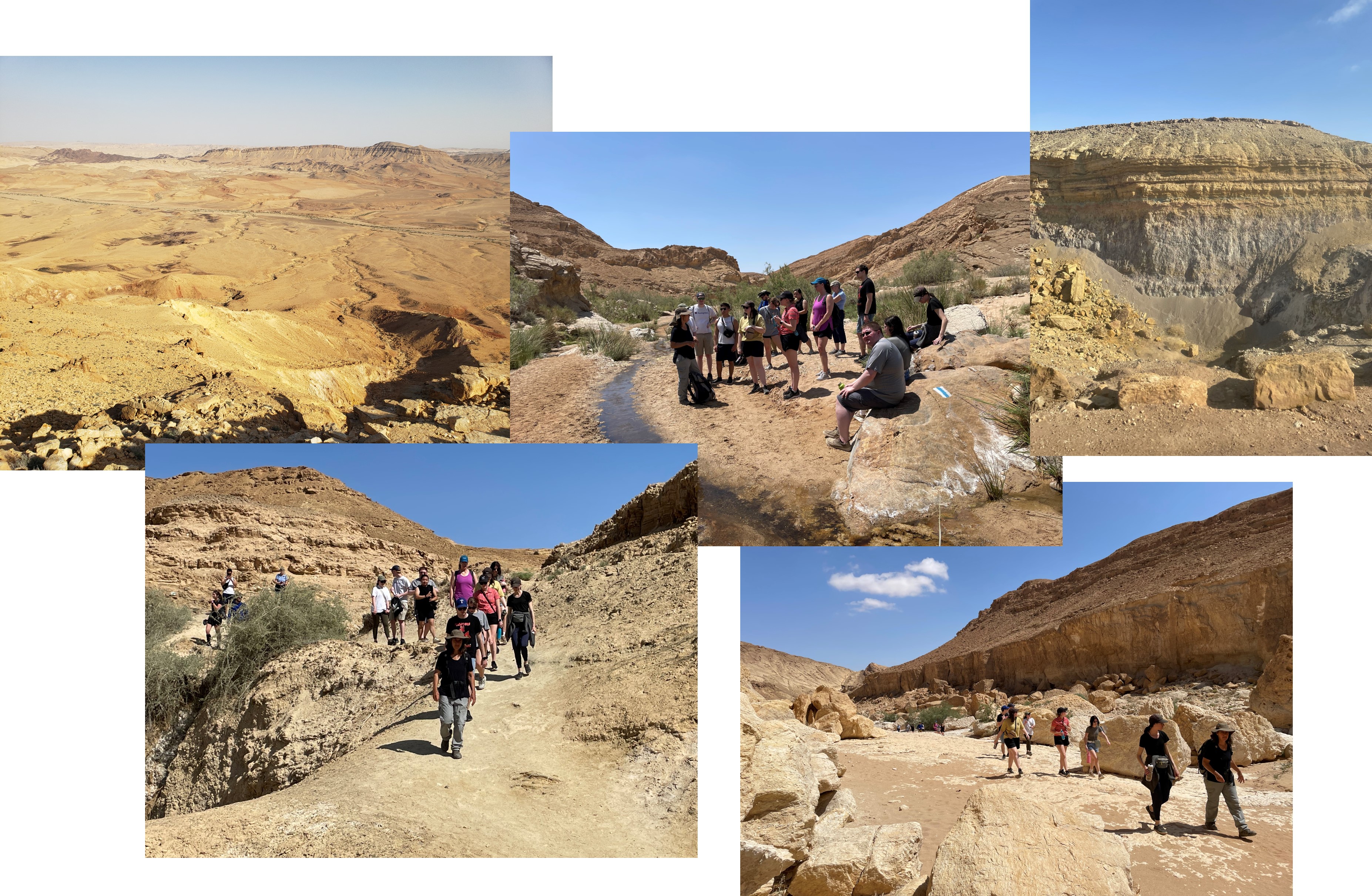Day Six – The Edge and Back Again: Ramon Crater and Wadi Aricha
By: Emily Loomis '24
This article is part of a series of reflections prepared by students enrolled in the Texas A&M School of Law 2023 Global Field Studies Program: Israel. Click here to visit the entire series.
Ramon Crater
Our day started early on May 13th. We drove into the Ramon Crater and began our day with a short (hot) hike through the crater. Descending into the crater was epic–dizzying roads, massive cliff faces on all sides, and sporadic clumps of greenery marked our journey to our hiking spot. As we began our hike, I was struck by how massive the crater truly was compared to the small country of Israel. Our guide told us about the formation of the crater, millions of years ago. The Ramon Crater was formed when the tectonic plates in Africa shifted. Israel is the only place on Earth where tectonic plate-formed craters are present. Our guide pointed out the layers of sandstone and limestone that made up the sides of the crater. She stated that the sandstone layer was formed nearly 500,000,000 years ago and the limestone was deposited 100,000,000 years ago. When the African plate collided with the Eurasian plate some 80 million years ago, many islands, mountains, and new bodies of water formed. Rain and rivers washed out the softer sandstone from the Great Rift Valley, leaving behind a crater with steep sides.
 Hiking through the Ramon Crater
Hiking through the Ramon Crater
While walking through the crater, it began to make sense why the people of Mitzpe Ramon felt so connected to it. There is an otherworldly feeling to the Ramon Crater, a sense of atemporal existence that certainly appeals to one’s spirituality. It also makes sense why so many people want to camp, hike, and interact with the crater. A central issue facing this area is the balance between tourism, which is a key industry for Mitzpe Ramon, and conservation/protection of the crater itself to preserve it for generations to come. A focal point of this conflict is a glamping site in the crater, which many tour guides and conservationists consider a pollutant to the serenity of the crater due to light, noise, and water pollution that the glamping site emits. Critically, the glamping site’s owner wants to put in an amphitheater, which worries the opposing side since they believe it will drastically increase the pollution of the glamping site. Additionally, the glamping site uses a cesspit for sewage, adding to the pollutants in the groundwater.
I think it is important to note that the glamping site in the crater is not full of people who hate the environment. On the contrary, the people who pay to be there do so for much of the same reason the Mitzpe Ramon people choose to live in the nearby town: they want to experience the magic of the crater. The issues surrounding the crater are like land issues everywhere–balancing business/tourism with the preservation and conservation of beautiful places. There is not an easy solution, but the crater did provide us with an opportunity to explore how a device like Laguna’s solar-powered wastewater treatment facility may be used in remote areas to ease such a conflict. The Ramon Crater is much like Israel itself–it is filled with beauty, wonder, and complex issues that are not easy to untangle.
Bedouin Village - Salman Sadan
After leaving the crater (and drinking a lot of water), our group drove to Wadi Aricha, a nearby Bedouin village. We had learned previously in the week about the socio-political issues facing many Bedouin villages in Israel. The Bedouin community lives in recognized, unrecognized, and semi-recognized villages. Israel provides some resources and connectivity to the Israeli water system to recognized villages, has promised such connections to semi-recognized villages, and withholds resources from the unrecognized villages. The categorization of Bedouin villages largely impacts what community members living in these villages have access to and their status in the eyes of the state.
Salman Sadan, a village representative, took his time, all while prepping coffee and bread for us over the fire, to walk through his experiences as a Bedouin living in an unrecognized village. He explained that sometimes the military would come and destroy crops and confiscate their herds. The government outlawed the traditional goat species used by his village, so they had to shift to sheep. This drastically changed production because instead of grazing the goats–who were hardy and adapted to the harsh desert life–they had to buy food for the sheep, which require more upkeep and care. This added cost was yet another burden Salman’s community faces. Additionally, Salman told us about how the military would come and destroy unrecognized village structures. The tent we were sitting under had been rebuilt because of this.
As I think about our conversation with Sadan, I am struck by the stark contrast between his village and the kibbutz we stayed in for a few days. The kibbutz was developed, full of greenery and industry, and seemed to be brimming with opportunities for the community members. Salman’s village, though there was some plant and animal life, was largely a harsh desert. The structures looked worn and haphazardly built, likely due to the knowledge that the military could come in at any moment and force the Bedouins to move. The dichotomy between the Bedouin village and the vibrant kibbutz was astonishing.
We were served a traditional Bedouin meal by the women of Salman’s family. Huge trays of food were placed in front of us, and traditional Bedouin bread was passed out. It was delicious!

Enjoying a traditional Bedouin meal in Salman’s home
We sat in the male part of the tent, where meetings and business were discussed. The Bedouin women were behind a curtain with the children. The change from nomadic to sedentary life greatly impacted the role of women in Bedouin society. They had to take over the agricultural practices, cook, clean, and rear children while the men had to go to work to bring in money. The Bedouins are a patriarchal, tribal society so the impact of men having to go to work has dramatically changed the family structure. Salman discussed the increase in violence among Bedouin communities and attributed it to the destruction of their family units and lack of education in the traditional Bedouin way of life. Education is a right in Israel, but Salman said that the schools were also erasing the Bedouin identity. He wanted to homeschool his kids, but the state would not allow him to do so. The breakdown of Bedouin society’s social order also meant that the actions of Israel were chipping away at Salman’s and thousands of other Bedouins’ identities as indigenous people.
Much of Salman’s talk reminded me of the United States’ treatment of its indigenous peoples. Like the Bedouins, Native Americans were forced onto lands unsuitable for their way of life. Their kids were “educated” but also forced to assimilate and leave their indigenous identities behind. Lack of economic opportunities and a dramatic change in Native Americans’ family structure led to an increase in violence and crime on reservations. All of these things seemed to have been repeated by Israel against the Bedouin communities, in both recognized and unrecognized communities. Salman, like so many other Bedouins we met, is desperately trying to maintain his identity and his community’s identity. He has garnered relationships with local Jewish community members and municipalities, but the state government still is an obstacle for his initiatives. Salman seems to have been labeled a “troublemaker” by the authorities precisely for his tireless efforts to help his village thrive.
Our talk with Salman ended on a bittersweet note. He told us that he had bought land in Jordan, a country that is more favorable to Bedouins, and planned to start a tourism business there that he would then pass on to his sons. As our dinner slowly grew to a close, the plates were taken away, the coffee was drunk, and our minds were spinning for ways to include the Bedouins in our project.
Israel is at a tipping point in many respects. The treatment of its indigenous communities seems to be largely unknown by local Israelis. There does not appear to be animosity from Jews against Bedouins–rather there appears to be a genuine ignorance by many Israelis of the treatment of Bedouins by their government. I think it is apt to end this blog post with this: injustice anywhere is a threat to justice everywhere.
Learn more about Texas A&M University School of Law's Global Law and Policy Program, Aggie Dispute Resolution Program, and Energy, Environmental, and Natural Resource Systems Law Program
